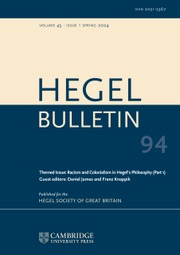Article contents
Searching for Modern Culture's Beautiful Harmony: Schlegel and Hegel on Irony
Published online by Cambridge University Press: 22 April 2013
Abstract
Goethe and Friedrich Schiller stand together immortalised in Ernst Rietschel's statue at the centre of Weimar. In their lifetime, Goethe and Schiller shaped the culture of German-speaking lands, not only through their poetry, plays, and novels, but also in their role as editors of journals that helped to set the intellectual tone of the period. Schiller's journal Die Horen (1795-1797) and Goethe's Propyläen (1798-1800), although short-lived, were important literary vehicles of the period and provided a forum that brought scientists, historians, philosophers, and poets into conversation with one another. The late 1700s and early 1800s were years of intense intellectual development in Germanspeaking lands; the arts flourished and aesthetics developed as a serious branch of philosophy.
During the ‘Age of Goethe and Schiller’, philosophy was dominated by Kant's philosophy and its post-Kantian variations. A problem with traditional philosophical histories of this period is the overwhelmingly Hegelian reading of it, a reading that subsumes all of the so-called minor figures under the shadows of the great system builder, Hegel. Richard Kroner's influential Von Kant bis Hegel of 1921 set the tone for this reading. Silenced by such narratives are the voices of the early German Romantics, a group of thinkers whose impudence created problems for them, and whose work posed hermeneutical challenges that continue to plague a proper understanding of the movement and the worth of its contributions. As we shall see, Hegel himself began to prepare the ground for a history of philosophy that would dismiss the contributions of the early German Romantics, a dismissal that is unfair and unfortunate: unfair because it is based on false characterisations of the movement, and unfortunate because such misreadings lead us to overlook the wealth of insights offered by the early German Romantics.
- Type
- Research Article
- Information
- Bulletin of the Hegel Society of Great Britain , Volume 31 , Special Issue 2: Special Issue on Hegel and Literature , Autumn/Winter 2010 , pp. 61 - 82
- Copyright
- Copyright © The Hegel Society of Great Britain 2010
References
- 1
- Cited by


